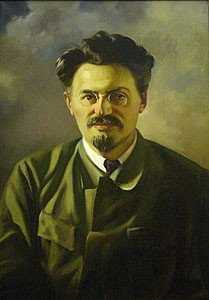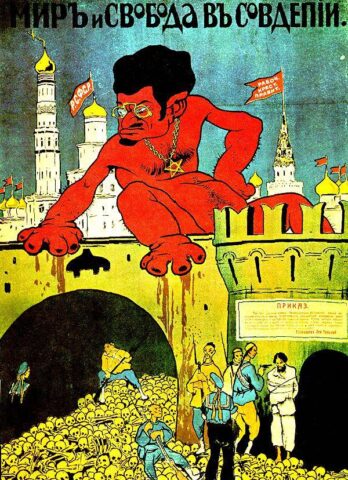
Until the decline in Lenin’s in 1922, Leon Trotsky was the number-two man in the Bolshevik party and Lenin’s obvious successor. Trotsky was a crucial figure for almost the entirety of the revolution: from the creation of the Petrograd Soviet in 1905 to the crushing of the Kronstadt uprising in 1921. During this period he performed several significant roles: chairman of the Petrograd Soviet, creator and overseer of the Military Revolutionary Committee (Milrevcom), chief negotiator with the Germans in 1918, the architect of the Red Army, a Commissar for War and an influential economic strategist. While Lenin was the party’s intellectual figurehead Trotsky was in many respects its chief organiser. He possessed some of the charisma and leadership qualities that Lenin lacked, although his lack of political intuition eventually proved fatal.
Sent away to boarding school, the young Bronstein became involved in revolutionary politics, first as a member of the Narodniki and later as a Marxist. In his late teens, he became a union organiser and socialist propagandist. In 1900 Bronstein was arrested and sentenced to four years’ exile in Siberia. He escaped in 1902 with a forged passport bearing the adopted name by which he later became known: Leon Trotsky. In 1903 he attended the Social Democrats’ Congress, where he initially sided with the Mensheviks.
“Trotsky moved like a bright comet across the political sky. He first came to global attention in 1917. By all accounts, he was the finest orator of the Russian Revolution. He led the Military-Revolutionary Committee… He did more than anyone to found the Red Army. He belonged to the party Politburo and had a deep impact on its political, economic and military strategy. The whole world attributed the impact of the October Revolution to his partnership with Lenin. [But] before 1917 Trotsky had been an enemy of Bolshevism, and many Bolsheviks did not let him forget it.”
Robert Service
In August 1917 Trotsky observed that “the factory committees… are in an overwhelming majority made up of Bolsheviks. In the Petrograd trades unions everyday practical work… lies wholly with the Bolsheviks. In the workers’ section of the Petrograd Soviet, the Bolsheviks constitute an overwhelming majority.” Trotsky himself worked for the Bolshevik cause in the Petrograd Soviet (he was elected chairman there again in early October). He also took a leading role in organising the Red Guards, a militia comprised of factory workers.
Joseph Stalin, later Trotsky’s bitter rival, wrote in 1918 that “all practical work in connection with the organisation of the uprising was done under [Trotsky’s] immediate direction… the Party is indebted primarily and principally to Comrade Trotsky for the efficient manner in which the work of the Military Revolutionary Committee was organised.” Once Stalin had seized the reins of power, this passage was expunged from official records.

Trotsky’s importance continued into the new society. He was an important member of the Communist Party Politburo and the lead negotiator with the Germans at Brest-Litovsk. Trotsky’s organisation of the Red Army and political and military leadership during the Civil War was also critical. But Trotsky was not without his faults. While he was a rousing public speaker and a brilliant theorist and organiser, Trotsky was also prone to arrogance, dismissiveness and sarcasm, qualities that made him unpopular with other Bolsheviks. These shortcomings were identified by Lenin in his 1922 ‘political testament’, where he acknowledged Trotsky’s talents but noted that he “displayed excessive self-assurance and… excessive preoccupation with the purely administrative side of the work.” Trotsky’s over-confidence eventually proved fatal when Stalin, his arch-nemesis, outmanoeuvred him and seized control of the party in the early 1920s. By Lenin’s death in early 1924, Trotsky had been virtually excluded from power. Stalin eventually had him expelled from the Soviet Union in 1929.
Trotsky spent the rest of his life in exile in France and then Mexico, where he wrote prolifically. In 1930 he penned a history of the Russian Revolution; several years later he wrote a scathing criticism of Russia under Stalin, titled The Revolution Betrayed. Back in Russia, Stalinist propaganda demonised Trotsky as a traitor, a saboteur and an enemy of the state. Trotsky was virtually written out of official Soviet histories of the revolution, while many of the problems of the new society were laid at his feet. In 1940 a Stalinist agent, Ramon Mercarder, was able to enter Trotsky’s home in Mexico and stab him in the head with an icepick. Trotsky died the following day.
1. Leon Trotsky, born Lev Bronstein, was a Marxist writer, orator and organiser who in 1917 became a significant Bolshevik leader.
2. In 1903 Trotsky sided with the Mensheviks against Lenin, though he later sought to reconcile the two SD factions.
3. In 1917 Trotsky returned from exile and began to work with the Bolsheviks, especially in the Petrograd Soviet.
4. He organised the Red Guards and Milrevcom and supported Lenin’s call for an armed insurrection.
5. Trotsky later negotiated peace with the Germans at Brest-Litovsk, served as Commissar for War, formed the Red Army, led the Civil War effort and was a pivotal member of the Politburo. He was eventually elbowed out of positions of power by Stalin.
© Alpha History 2014. Content on this page may not be republished or distributed without permission. For more information please refer to our Terms of Use.
This page was written by Jennifer Llewellyn, John Rae and Steve Thompson. To reference this page, use the following citation:
J. Llewellyn et al, “Leon Trotsky” at Alpha History, https://alphahistory.com/russianrevolution/leon-trotsky/, 2014, accessed [date of last access].

